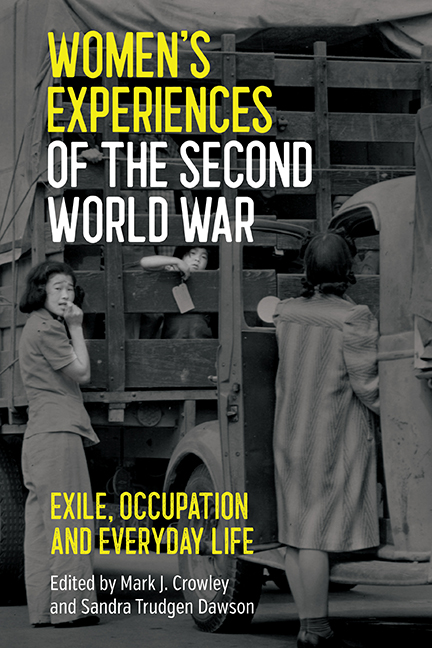Book contents
- Frontmatter
- Dedication
- Contents
- List of Illustrations
- List of Contributors
- Acknowledgements
- List of Abbreviations
- Introduction: Women’s Experiences of the Second World War: Exile, Occupation and Everyday Life
- Part One Living in Exile and under Wartime Occupation
- Part Two Living with Wartime Occupiers
- Part Three Everyday Life at Home and on the Battle Front
- Index
1 - Exiles Serving Exiles on the Homefront: Protestant Missionary Workers and Japanese Americans
Published online by Cambridge University Press: 03 June 2021
- Frontmatter
- Dedication
- Contents
- List of Illustrations
- List of Contributors
- Acknowledgements
- List of Abbreviations
- Introduction: Women’s Experiences of the Second World War: Exile, Occupation and Everyday Life
- Part One Living in Exile and under Wartime Occupation
- Part Two Living with Wartime Occupiers
- Part Three Everyday Life at Home and on the Battle Front
- Index
Summary
In an undated essay likely written soon after the Second World War, Quaker missionary Esther B. Rhoads reflected that the ‘evacuation [of all Japanese Americans from the West Coast during World War II] is indeed a black mark in our history’. She continued, ‘Our American record of treating persons of other races as equals has not been good’. Rhoad's clarity about the history of American race-relations that served as a precursor to the mass incarceration of 120,000 American citizens and residents of Japanese ancestry by their federal government during the war echoed the clear summary of the pathos facing Japanese Americans voiced by Presbyterian missionary to Japan, Gladys Walser. Of the Nisei, or second generation, she queried, ‘They are determined to win a place in the America they love. Shall it always be their fate to be thought Japanese when in America and Americans when in Japan? Or will we by fair play give them the right that is theirs by birth – to be Americans?’ Rhoads and Walser exemplified the concerns of many of the Protestant missionaries who found themselves also exiled from their chosen home during the war. Their belief in the equality of all, undergirded by the broad worldview of Christian internationalism, drove many missionary women to spend the war years challenging American racism as they worked with and on behalf of Japanese Americans.
Separated from their work in Japan by the war, many furloughed Japan missionaries turned their energies toward the plight of the incarcerated Japanese American, or Nikkei, population in the United States. Missionaries felt they had much in common with people expelled from their communities, and displaced from all the daily markers of their lives. While male missionaries more easily found leadership positions in agencies and committees formed to help Japanese Americans, or as pastors in the camps, female missionaries often had to come at the work aslant. They faced gender barriers in their efforts to challenge racial prejudice. Engaged in ministries of presence in the precarious months before the mass deportation of Nikkei from their West Coast homes; as social workers, church workers, or visitors to the camps during the years of incarceration; or as hosts at hostels for dislocated families in the months after exclusion ended, their efforts underscored the improvisational nature of female missionary work.
- Type
- Chapter
- Information
- Women's Experiences of the Second World WarExile, Occupation and Everyday Life, pp. 11 - 28Publisher: Boydell & BrewerPrint publication year: 2021



